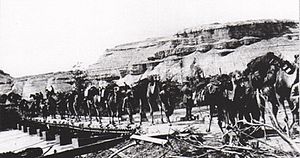Egyptian Camel Transport Corps
The Egyptian Camel Transport Corps (known as the CTC, Camel Corps or Camel Transport) were a group of Egyptian camel drivers who supported the British Army in Egypt during the First World War's Sinai and Palestine Campaign. The work done by the 170,000 men of the Corps helped British war operations in the Sinai desert and in Palestine and Syria by transporting supplies to the troops in extreme geographic and weather conditions.
Britain had occupied Egypt and controlled the Egyptian government after invading the country during the 19th century. At the beginning of the war, Britain set up the Protectorate of Egypt and imposed Martial Law, giving a solemn pledge to defend Egypt and not call on the Egyptian people to aid them in the conflict. However, the British quickly came to realise they desperately needed the support of Egyptian labour, camel drivers and their camels in a land that was so inhospitable to Europeans. The great value of this service was also acknowledged by General Allenby in his Despatch of 16 December 1917 where he mentions their steadiness under fire and devotion to duty.
Early in the conflict, volunteers for the Egyptian Camel Transport Corps, often from extremely poor villages, like those in the Egyptian Labour Corps were given a daily inducement of 7 Piastres (one shilling and six pence) and rations. Later it was necessary to utilize the already imposed British military authority over all Egyptian officials and civilians. Then the Muidir, Lord Lieutenant or Omdah, mayors of Egyptian towns, for a consideration organised press gangs and the necessary native armed guards to keep the forced labour at work. Members of the Egyptian Camel Transport Corps were 'sealed' by a seal attached to their wrists for periods that appear to have started as quite short term but became quite extended as the importance of their service was recognised.
The members of the Egyptian Camel Transport Corps transported supplies to the fighting troops, from one end of the Sinai and Palestine Campaign to the other; from the desert of the Egyptian Sinai Peninsula to the northern Levant (now Syria). They saw service transporting supplies of all kinds across the flooded plain north of Gaza and Beersheba, up into the rocky inhospitable Judean Hills towards Jerusalem in late 1917, down the precipitous tracks to Jericho in the Jordan Valley, up into the even less hospitable hills of Moab towards Es Salt and Amman and also followed on the great victorious advance northwards in 1918, carrying ammunition, water and all types of stores for the men and horses of the fighting units at the front, and carried the wounded back.
...
Wikipedia

